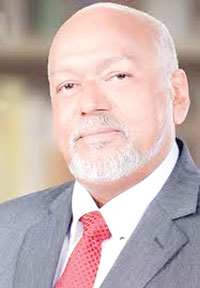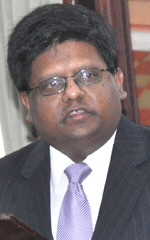Ahead of impending general, regional elections… Rohee deems economic and social indicators ‘signals of progress’
GUYANA is heading into early general and regional elections, and there are going to be certain perceptions on the part of the Guyanese people on whether economic and social progress has been made, and there will be judgments on this basis.
This fact was adumbrated by General Secretary of the ruling People’s Progressive Party (PPP), Mr Clement Rohee, who has expressed confidence that the party’s track record speaks volumes.
“There is no problem with these (economic and social advances) being the indicators of progress. It is for the people to judge whether there has been economic and social progress in the country, compared to what (obtained) under another regime and compared to what existed before. The track record of the PPP/C speaks for itself,” he said in an interview with the Guyana Chronicle on Monday.
His view is that the PPP/C has made significant advances in both spheres, in line with the principle of the party’s founder, the late Dr. Cheddi Jagan, who held the view that Guyana’s development must have a ‘human’ face to it.
“Significant social and economic progress has been made,” Rohee said. “Our projects have been people-centred in terms of water, housing and infrastructural advances. Projects advanced by the PPP/C administration have benefited all Guyanese.”
SOCIAL PROGRESS
Rohee said social advances are seen in the successes of the education, health and housing sectors, as well as in the support to vulnerable groups in Guyana.
The country has achieved universal primary education, he disclosed, and is on its way to attaining universal secondary education.
The current administration also has a policy that sees the distribution of free text books, payment of uniform allowances, provision of transportation aid, and the recently launched ‘Because We Care’ cash grant initiative. New schools, including technical institutes, have also been built, expanding access to education. There are also several training programmes to assist out-of-school youths.
Relative to tertiary education, there is a move to expand the University of Guyana’s (UG) distance education programmes.
The largest percentage of the 2014 Budget went to the Education sector, with an allocation of a whopping $32.3B, while Health received an allocation of $21.5B.
In the Health sector, increased services are being provided, and there is additional training to boost the sector’s human resource capacity, among other initiatives. Improved health delivery and service has resulted in improved life expectancy and reduced infant mortality, among other successes.
Also, this year, old age pensions were increased from $12,500 to $13,600 – up from $3,500 in 2006 – and old age pensioners now receive an annual electricity assistance of $30,000, an increase from $20,000, among other social security safety-net programmes.
Under vulnerable groups and other targeted interventions, the 2014 Budget provided $382.5M to consolidate efforts made in the delivery of childcare and protection services, and $796M for continuation of the Youth Entrepreneurship and Apprenticeship Programme (YEAP).
Another major social indication is housing and water; and in the 2014 Budget, housing received $4.4B and water received an allocation of $2.5B, while Sanitation received $544.6M. It is expected that by the end of 2014, a total of 5,900 house lots would have been processed, and 4,100 land titles would have been distributed to new landowners.
Housing scheme development is expected to continue at Eccles, Diamond, Anna Catherina, Uitvlugt, Bath, and No. 77 Village, among other places. In addition, through continuation of the public-private turnkey initiative, another 100 houses will be constructed, and an additional 50 police officers, nurses and teachers will be allocated land to construct their homes.
This year, the housing sector is expected to see completion and distribution of another 176 core houses; disbursement of 134 coastal home improvement subsidies valued at $26.8 million, and an additional disbursement of 54 hinterland subsidies valued at $54 million, benefiting a total of 1,248 persons. Also, subsidies for another 130 hinterland home improvement applicants, valued at $107.2M, were granted, increasing access to affordable shelter by the most vulnerable communities.
In the area of infrastructure, by the end of 2014, an amount of $13.7B would have been expended to improve the network of roads and bridges; of this sum, $12.9B will be spent on roads and $844.2M on bridges.
Also, the sum of $1.9B is expected to be spent on ensuring the further strengthening of our sea and river defence infrastructure.
Additional sums have been spent on drainage and irrigation, among other areas of work.
ECONOMIC ADVANCES
With regard to Guyana’s economic standing, Guyana has had real consecutive economic growth every year since 2006. This represents the longest period of uninterrupted real economic growth since Independence in 1966.
Growth as at mid-year, according to a report from Finance Minister Dr. Ashni Singh, reached the 3.2 per cent mark.
The economy is projected to grow by 4.5 percent in the full year 2014, with non-sugar growth projected at 3.6 percent.
Also, the private sector has made significant achievements in every area of endeavour, with investments taking place in mining, agriculture, tourism, commerce and information-based technology.
The service sector has also grown steadily, making an important contribution to Guyana’s economic progress. Also, over the years, Guyana has seen massive development in the construction sector.
EARLY ELECTIONS
These facts, Rohee stressed, will be considered by the voting Guyanese public once the date for early general and regional elections is set.
President Donald Ramotar, in early December, ended the wait of the Guyanese people with the much-anticipated announcement on the way forward to bring an end to the current political impasse – a move to early general and regional elections.
A move by the President to set a date will have a bearing on several processes. Once a date is set, it will translate to the dissolution of Parliament, which currently still stands suspended under the November prorogation proclamation. Political parties will then kick into campaign mode. And once a proclamation announcing a date is made by the President to go to general and regional elections, constitutionally, the Guyana Elections Commission (GECOM) has three months within which to deliver.
Asked for clarity on a timeline within which a date would be set for a return to the polls, the President assured that he would make the proclamation early next year.
The Head of State expressed confidence in his party regaining the parliamentary majority it lost in the 2011 general and regional elections by one seat. At the last elections, the combined Opposition gained control of the National Assembly by a one-seat majority in a 33-32 split.
President Ramotar credited his confidence to the Government’s performance in moving the country forward for the benefit of the Guyanese people, and to the experiences of the Guyanese people in the last three years.
The PPP General Secretary shared similar sentiments. “The combined Opposition keeps saying that the people gave them the combined majority in the National Assembly and this should be respected. Come next elections, if the people decide to return the PPP/C’s majority, this is a decision that should also (be respected) because the people would have spoken,” Rohee concluded.
(By Vanessa Narine)



